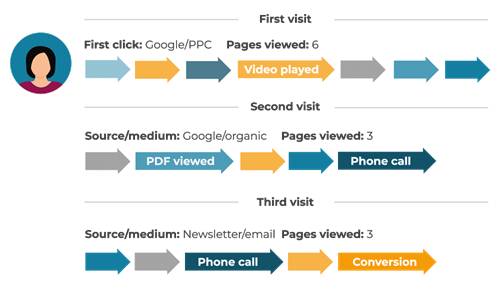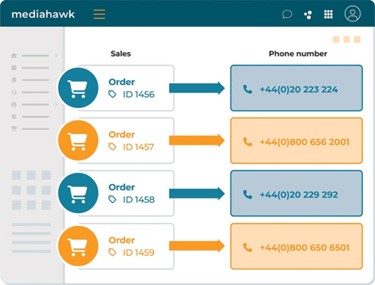Advertisement feature from Mediahawk
The automotive sector still very much relies on the phone channel.
It’s used at every step, from initial contact to conversion – from leads asking a question about model availability to arranging a customer’s pickup after their purchase. Even beyond the point of purchase, there are dozens of phone calls about servicing and repairs.
In every one of these calls, there’s essential information to capture about your leads. And by connecting this information with data captured in other channels, you can start to build a complete view of them.
The opportunities are near-limitless. But without the right tools, these insights can be easily missed.
We’ve recently explored the tactics you can use to build an effective automotive marketing strategy, using the electric vehicle market as an example. Now, we’ll uncover how you can capture the data to inform those strategies, understand more about your leads, and encourage more conversions.

Capture the data you need to understand your leads
As marketing costs rise and budgets shrink, having a strong foundation of data to inform your strategies becomes even more crucial.
“You need to understand what sources generate valuable enquiries, where your budget is best spent, and the specific journeys your leads are taking,” explains Faye Thomassen, Head of Marketing at Mediahawk. “Having this data behind you can help you ensure you have a consistent pipeline of leads for your business – and some insights to fall back on in moments of urgency.”
Using platforms like Mediahawk, you can capture more information about the leads you’re engaging with and build a complete picture of your marketing pipeline. And it’s easier – and less time-consuming – than you might think.
Here are some actionable tips you can implement into your strategy to start capturing the right insights.
Understand where your valuable calls come from with call tracking
You’ll no doubt be aware that Google is outlawing third-party cookies in 2025. It’s been a long time coming with a deadline that keeps getting pushed back – we’ve been writing about it for almost three years.
Ultimately, it means that using other tools to track a customer’s buying journey across multiple channels will be more important than ever. You’ll no longer have access to the convenient insights that third-party cookies currently capture.
Call tracking not only solves this problem, but also gives you access to greater insights than third-party cookies ever did . Using both static and dynamic call tracking, you can track every step a lead takes before, during, and after engaging with you. You’ll also be able to accurately attribute sales to specific channels and campaigns.
With these insights, you can adjust your budget spend in real time to increase conversions and lower cost per acquisition.

Identify the cost and value of every lead
Just as important as capturing the data is knowing what data to capture. Mediahawk’s reporting features – such as its source flow and attribution reports – can provide a wide range of valuable insights.
For instance, when combined with Sales Matching, the attribution report on the platform can tell you how fast a lead converted into a sale. With this information on all your leads, you’ll be able to identify which tactics accelerate conversions and which slow them down.
Other reports such as the source flow report can help you identify all your conversions in one place, including what contributed to them – whether it was a call, a form fill, live chat, or another channel. And if you have sales matching enabled, you’ll also be able to see the actual sales value of these conversions.
In addition to these insights, you can capture crucial data such as the costs of your leads and sales. These can help you calculate and understand the exact ROI of each channel, and attribute tangible value to your marketing activities.
“Mediahawk’s sales matching data can really help you understand where your budget is best spent and where to invest it in future campaigns,” adds Faye. “As the costs of paid channels continue to increase – and competition in those spaces grows – it’s data like this that will really help you optimise your spending.”

A new strategy built on call tracking data
Dick Lovett, a privately owned dealer group in the South West of England and Wales, uses Mediahawk’s call tracking and Sales Matching capabilities to accurately link marketing activity directly to revenue.
“We quickly gained an understanding of what was working from our different marketing channels, and in particular, what was driving traffic to our website. Over time we’ve been able to modify our marketing strategy based on the hard data Mediahawk has provided.”
– Russell Brown, Group Marketing Manager, Dick Lovett
Use data from Mediahawk to inform new AI-powered tools
Fortunately, the opportunities for automotive marketers to extend the value of their budget are only growing. New AI-powered tools like Google’s Performance Max can help you reduce wasted ad spend by focusing on the ads and networks that deliver conversions.
Feeding the tool the first-party data captured by Mediahawk’s call tracking, you’ll be able to give Performance Max “positive signals”. These signals direct the tool’s attention to capture specific audiences based on previous conversions.
For example, these signals could look like calls over a certain length that indicate high intent or keywords that trigger a voice tag in your speech analytics tool.
Additional features such as Google’s new vehicle ads, sometimes known as Vehicle Listing Ads (VLAs), extend the value of Performance Max even further. Vehicle ads are a performance-focused, lower funnel ad format that helps automotive marketers promote their vehicles on Google – similar to the current shopping ads available in other retail markets.
“Tools like Performance Max and Google’s Vehicle ads will really help marketers get the most from their budgets. It’ll eliminate some of the manual testing needed to understand which keywords and creative assets are most valuable, and automatically reach the right audiences at the right time.”
Colin Hudson, Head of Client Services at Mediahawk.
Compare performance across multiple locations and products with Parameter Connect
Many automotive dealers have a national reach with multiple locations, but comparing performance across those locations can often be difficult.
With Parameter Connect in Mediahawk, you can gain more visibility of how your different locations perform. By assigning parameters to the phone numbers and sources associated with each location, you can view the performance across all your dealerships in one report.
In the report, you’ll be able to see which locations need your attention and identify the tactics being used by the strongest-performing locations.
It’s still a valuable tool even if you’re operating in a single location. Parameters can also be applied to different products – such as car models or new/second-hand vehicles – to compare their performance. For example, you might be able to identify that second-hand Volvos are particularly popular with a specific demographic of customers, offering you valuable information to guide your marketing tactics for the product.

Summary
As competition grows in the automotive sector and customers continue to gain more ways to purchase vehicles, understanding their behaviour and intents will become even more important.
Building a strong foundation of data in Mediahawk will help you identify what tactics generate leads, what converts them, and where you need to focus your attention. You can eliminate the guesswork and ensure your marketing budget is working as efficiently as possible for your business.
Book your demo today to see how the insights you capture from Mediahawk could transform your automotive marketing strategy.














Login to comment
Comments
No comments have been made yet.